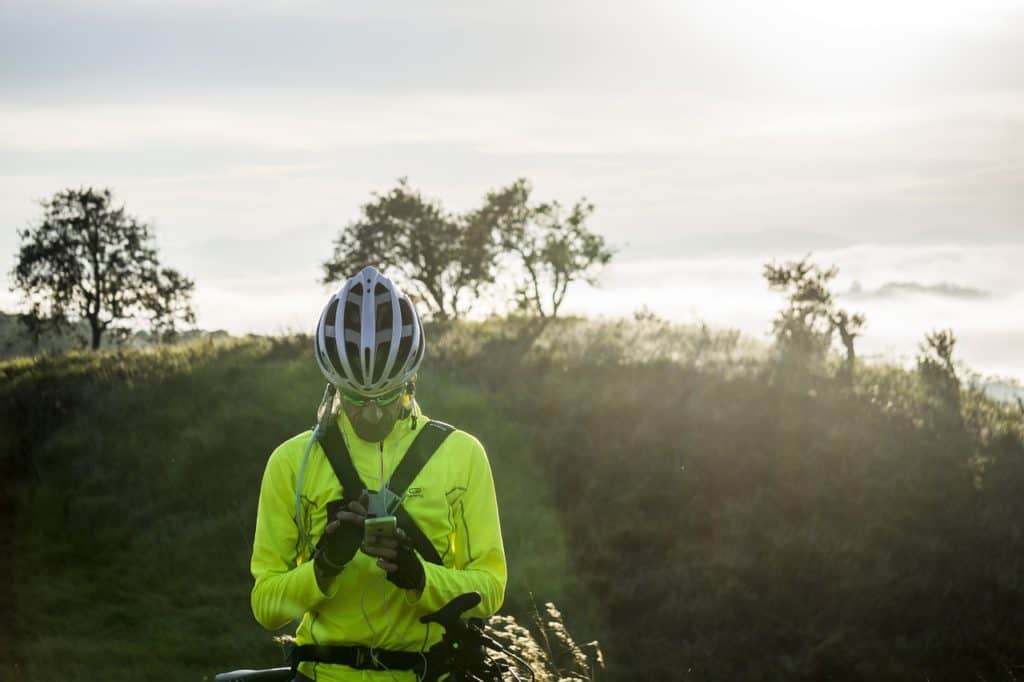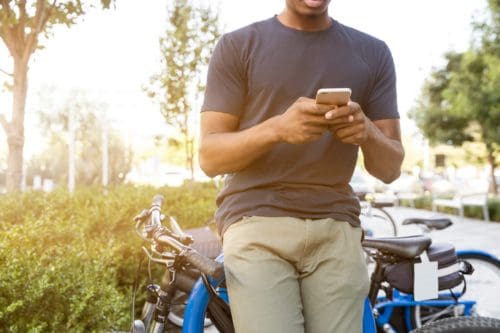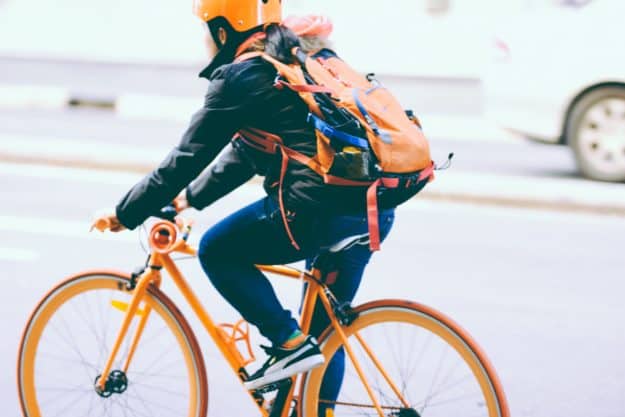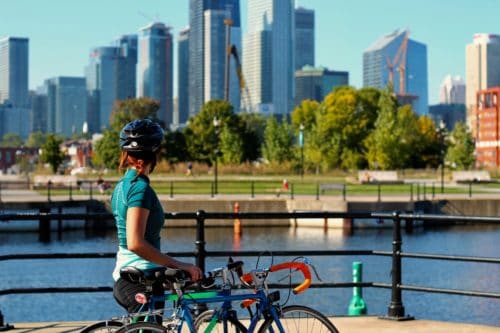This post may contain affiliate links. If you click an affiliate link and make a purchase, I may earn a commission. Also, as an Amazon Associate, I earn from qualifying purchases.--
More people than ever are pulling their bikes out of the garage and bicycling to work. Everyone has to get to work one way or another. Why not enjoy the outdoors and exercise while you’re at it?
Riding to work can turn a boring commute into some fun, but it is important that it be safe too. Unfortunately every year there are bicycle related death and injuries on the road.
No one plans to crash their bike, but it happens for a variety of reasons.
The good news is that there are safety techniques and tips that reduce your chances of getting injured while on your bike commute.
Below I have listed a few bike safety statistics from previous years. We share these statistics not to scare you, but as a reminder that accidents do happen!

Bike Safety Statistics
- In the United States, over 1,000 bicyclists died and there were nearly 467,000 bicycle-related injuries.
- Those who have the highest bicycle death rate are adults between the ages of 50 to 59.
- Males are 6 times more likely to die on bicycles than females.
- Males are 4 times more likely to receive a bike-related injury than females.
- One third of all bicycle related injuries are from children between the ages of 5-14 years and adolescents between the ages of 15-19 years old.
- 37% of all bicyclist deaths that occurred between a motorist and cyclist involved alcohol.
- The majority of bicycle deaths happen in urban areas and not at intersections.
If you’re interested in getting into the details you can look at the data where we got these statistics here and here.

Bike Safety Tips
Accidents, injuries, and even death can happen while riding a bike, but there are ways to minimize the risk.
I have put together a list of 24 bike safety tips to keep you safe and having fun.
If you take these safety guidelines to heart you can ride easy knowing you are less likely to get into a crash. Here are 24 Bike Safety Tips To Keep You Safe and Sound:
#1 – Protect Your Head
Even if your bike commute is a short distance you always want to wear a helmet. Even if it’s a quick ride to the grocery store you want to make sure you’ve got your head protected.
A simple small crash can result in severe injuries if you land on your unprotected head. Helmets truly can save your life.
You want to make sure that you have a helmet that fits you correctly and is tightened properly.
Don’t wear a helmet that is too small or one that isn’t cinched down properly. For more guidelines on helmet use and our personal recommendation check out our helmet buyer’s guide.
#2 – Obey Traffic Regulations
One of the questions that new bike commuters ask is, “Do cyclists have to obey traffic laws?”
The answer is unanimously yes. This means fully stopping at stop signs. This is a tough law to abide to, because I know what its like to come to a stop sign and see no cars in proximity.
The urge will be to slow down and roll on through a red light, but for your own safety please take a complete stop.
Story time – one morning I approached an intersection with the light on red and rode through it. There were no cars around. Unfortunately a parked police officer saw me, and pulled me over.
It’s the only time I’ve been pulled over by a cop while on my bike. He questioned me asking why I rolled through the stop.
I told him the truth that I intentionally ran the red light, but that no cars were around.
The truth didn’t satisfy him. Bikes are to obey all traffic regulations. Luckily, he didn’t ticket me and only gave me a warning.
While it may be tempting to not follow traffic regulations exactly they’re put there to keep cyclists and motorists safe. It may slow down that momentum you built up pedaling, but follow those traffic laws.
#3 – Be Visible
After years of riding and hearing about bike crashes I automatically assume that motorists do not see me. You should hold this assumption too.
Be ready to react if a car starts moving in your direction. Sometimes this means yelling loudly to get their attention!
With this said, there are ways of making yourself more visible to motorists. One way you can be more visible is to wear clothing with reflective accents.
Making sure that your bike is equipped with a bright light on the front and blinking red lights on the back will help drivers spot you.
#4- Go With the Flow
While riding a bicycle you want to go with the flow of traffic. Inexperienced cyclists often go against the flow of traffic, and this is a huge no-no!
Many accidents have occurred due to riders going against traffic. The reason why you want to ride in the direction of traffic is because it gives motorists more time to notice you and react.
Also when you ride with the flow of traffic it makes it easier for motorists to pass you. Lastly, going with the flow puts you in a position where you can see and follow traffic lights and signs.
#5 – Make Eye Contact
You come up to an intersection, and you’d like to assume that everyone sees you, but that would be a mistake. If you’re able it helps to make eye contact with drivers so that they acknowledge that they see you.
Plenty of times I assumed a motorist saw me only to realize by their driving that they had no clue I was there. Try to make eye contact if possible.
#6 – Is Your Bike Ready?
Before you take off for your ride perform the ABC check on your bike.
The A stands for air.
Are the tires on your bike filled with the proper amount of air? Low pressure tires increase the chance of getting a flat tire on the road.
Tires that are inflated to the right pressure will give you a smoother and faster ride. Tires leak air over time, and so you should regularly check their pressure.
The B stands for brakes.
Are your brakes working properly?
Make sure that they’re not rubbing against your tire as the resistance will wear the brakes down quicker and give you a harder workout.
You want to make sure that your brake pads are more than 1/4″. If they’re less than a 1/4″ thick it’s time to replace those pads. Give the brakes a quick check too. You don’t want to get on the bike and find yourself flying downhill only to discover the brakes aren’t working properly!
Finally, the C stands for the chain.
Give it a quick look over to make sure it’s not full of gunk or rust. If it is, you’ll need to wipe it off and give it a fresh application of lubricant.
Before every ride you’ll want to quickly go through the ABC check to make sure your bike is ready to go!

#7 – Put the Phone Away
There’s a reason why many states have instated a law that you need to be hands free while driving a car.
Currently it is legal in the United States to use a cell phone while riding a bicycle, BUT we strongly encourage you to not utilize this freedom.
Talking while holding a phone distracts you from your surroundings, and you won’t have complete control of the bike.
Imagine a squirrel shoots in front of you while you’ve got one hand holding the phone to your ear. Without both hands on the handles there’s a high chance you’re going to crash and burn.
Well maybe you won’t burn, but you might break. Keep the phone in your pocket. If you need to talk, stop the bike, and do so.
#8 – Use the Bike Lane
If you live in a city that has invested in a bike lane than use it.
Not all cities and routes have a designated bike lane, but if you’re fortunate enough to be on a road that does, make sure to ride on it.
If the bike lane is blocked by a stopped vehicle, garbage can, or other obstacle feel free to pass around it as you would in a normal vehicle, but check over your should for cars behind you.
In most cities, it is ok for a bicycle to be in a full lane that cars utilize if needed. You should be on the right side of the road as much as you’re able.
If you are intentionally taking a full lane when there is a usable bike lane you’re liable to be cited by a police officer or at least fuel the animosity that some motorists have for cyclists.
#9 – Act Like a Car
Motorists are familiar with the patterns of other drivers, and as a bike commuter you want to act similarly. As you ride to work you want to treat yourself as if you’re driving a car.
This means stopping at red lights, turning when appropriate, and passing correctly. As a cyclist you do not have the right of way over a vehicle.
There are circumstances when a motorist may give you the right of way by motioning, but generally you should not expect the right-of-way on the roads.
#10 – Watch for Doors
One of the most common ways for bicyclists to go down while riding is from a motorist opening their door.
I have personally had many close calls with car doors, but have remained unscathed from being hyper-vigilant and scanning for potential “door openers.”
When you are riding your bike next to parked vehicles it is common for drivers and passengers to throw open their door to get out of the car without checking to see if a vehicle or cyclist is coming.
If you’re not paying attention you can either plow right into the door or swerve into traffic. Both of these situations aren’t good.
Train yourself to look at parked vehicles and see if there are passengers. If you notice someone sitting in the car be ready to stop or move around the door.
#11 – Don’t zip from sidewalk to street
To avoid accidents make sure to ride predictably. If you’re zipping from the sidewalk to street and back again you’ll make it difficult for cars to know what you are planning to do.
Keep in a straight line.
This goes for being in the bike lane as well. Don’t swerve, but keep straight.
#12 – Use Arm Signals
There are at least three arm signals that are important to remember. They signal that you are stopping, turning left, and turning right.
Using these signals will help motorists and other cyclists know what action you’re planning to do.
Left Turn – Extend your left arm completely out and use your index finger (or hand) to point left.
Right Turn – There are two options here. The first option is to extend your right arm out completely and use your index finger (or hand) to point right. The other option is to use your left arm and extend it sideways, but bend it at the elbow to make an upward 90-degree angle. Your hand should be pointed upward.

#13 – Look Ahead and Anticipate
One practical skill to keeping safe on your bike commute is to constantly scan ahead for obstacles, hazards, and other potential problems in your path. Look ahead for potholes, rocks, other cyclists and motorists.
While scanning you should anticipate what other motorists are planning on doing, and be ready to react appropriately.
For instance, if you see ahead that a parked car on your right has their left blinker on you should be ready for them to pull out on the road. I know I have said this before, but don’t assume that others see you.
#14 – Lights at Night
Riding at night without a light is dangerous. You won’t be able to see ahead of you clearly nor will others be able to see you.
Get yourself a bike light to make yourself visible to others and to light your path. We would also recommend purchasing a couple small red blinking lights to help others see you.
#15 – Hands & Feet on the handle/pedals
By keeping your hands on the handlebars and your feet on the pedals you’ll be in better control and reduce the chances of you crashing.
#16 – Brake Properly
When coming to a stop start with by applying pressure to your rear brake and than adding pressure to your front brake.
If you know you’ll need to stop start slowing down at an appropriate distance so you won’t need to jam on the brakes.
If you slam on the brakes while on a bike it can lead to you skidding out or flying over the handlebars. Neither of these are fun.
#17 – Don’t Hold Vehicles
Some of you are real daredevils and have grabbed hold of a moving vehicle to gain some speed. This goes without saying, but while this may be exciting it is very dangerous.
#18 – Ride Conservatively
Have you heard of defensive driving?
I’d like to start a new term called “defensive cycling.” If you go on your ride with an attitude of riding conservatively you’re more likely to be safe.
You don’t need to race to beat the red light or shoot through traffic. Ride your bike conservatively and you’ll be safer than if pedaling like a bat out of hell.
#19 – Don’t Take Passengers
I had a friend sit on my bike rack while I pedaled back to my home. She was wearing sandals and her bare foot went in the chain. It looked like hamburger meat.
All this to say, taking a passenger on the bike rack or sitting on your handlebars might be fun, but it’s not safe.
#20 – Bike Fits You
Make sure that your bike fits you. Riding a bike that is too small or too big will be difficult for you to handle. Keep safe and only ride a bike that fits you.
#21 – Items in a Bag, Pannier, Backpack
I have seen cyclists carrying their groceries in one hand with their other on the handle bars steering.
If you have any items that you want to travel with you (laptop, books, groceries, etc.) get a bag to carry these items so that you can pedal with your hands on the handlebars.

#22 – Plan a Safe Route
Sometimes it is worth tacking on a little more distance to your bike commute to travel on a safer route.
There are some roads that are so congested or in poor condition that it is safer to steer clear of them. If you’ve got the flexibility choose a route with good road conditions for you and your bike.
#23 – Don’t Get Stuck in Your Chain
If you’re wearing shoes with laces make sure they’re tied well and not flopping about. You should also tuck your pant leg into your socks.
This is important so that your shoes laces and pant legs don’t get stuck into your chain forcing you to an unexpected and forced stop.
#24 – Announce Yourself
In my hometown there is a bike path with lots of tourists walking on it. They’re often clueless walking aimlessly and soaking in the sites.
Knowing that they’re caught up in the scenery and not watching for cyclists I don’t pass them without announcing that I am coming.
Even when passing other bicyclists I announce “on your left!” loud enough so they can hear me. Make sure you are loud enough that they can hear you.
The other option is to mount a bell on your handlebars. While living in Amsterdam I quickly realized that a bell meant that a cyclist was coming your direction.
If you’ve got a bell on your bike you can give it a ring to let pedestrians and other cyclists know that you are coming.
Keep Safe Out There and Happy Commuting!
These are our commuter bike safety tips. We hope that at least a few of these tips were new to you, and that they help you to rider safer.
No one thinks they’re going to be in a bike accident until it happens. Be proactive and implement these safety guidelines so that you won’t be a statistic. Enjoy your commute to work!
